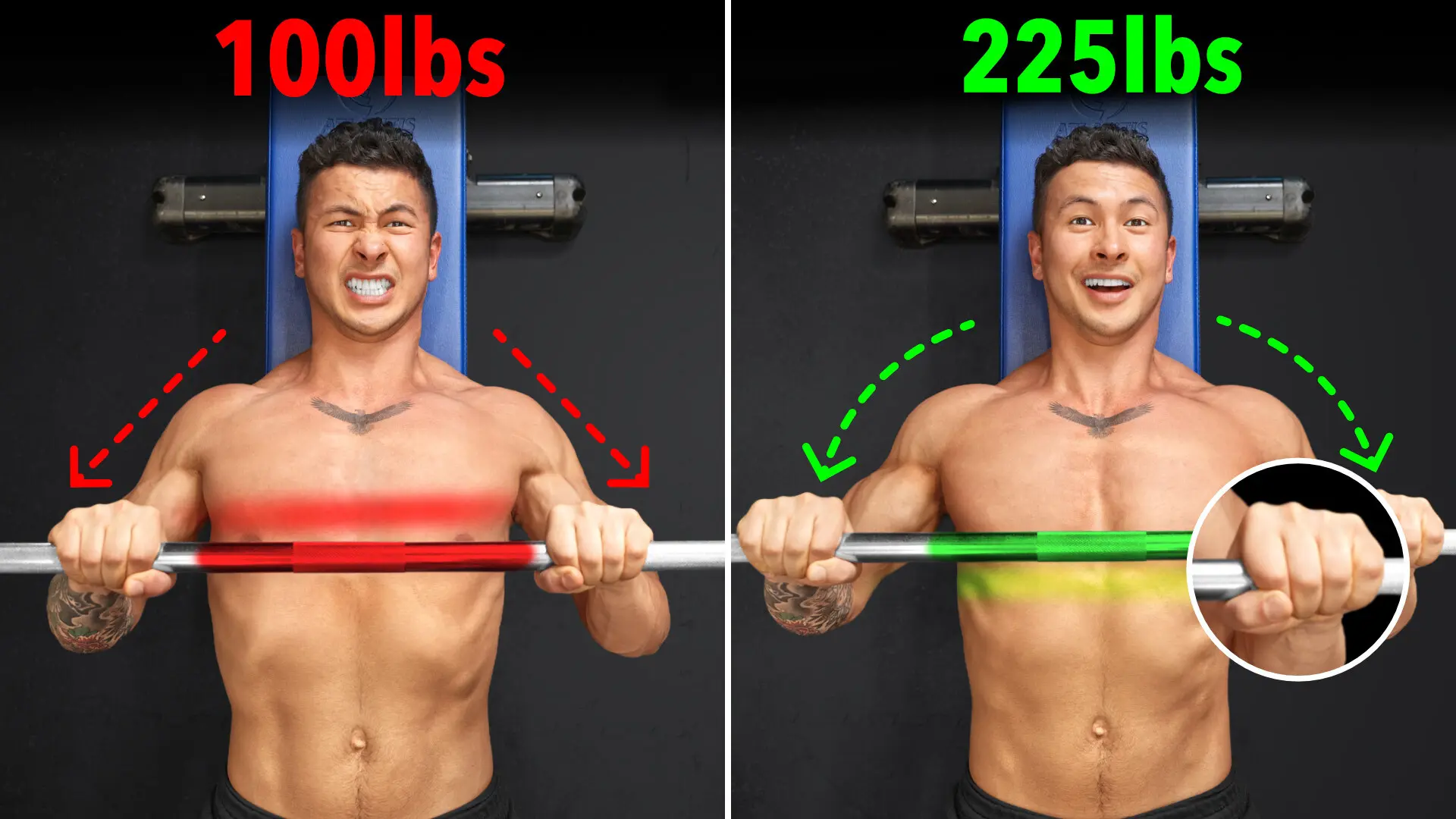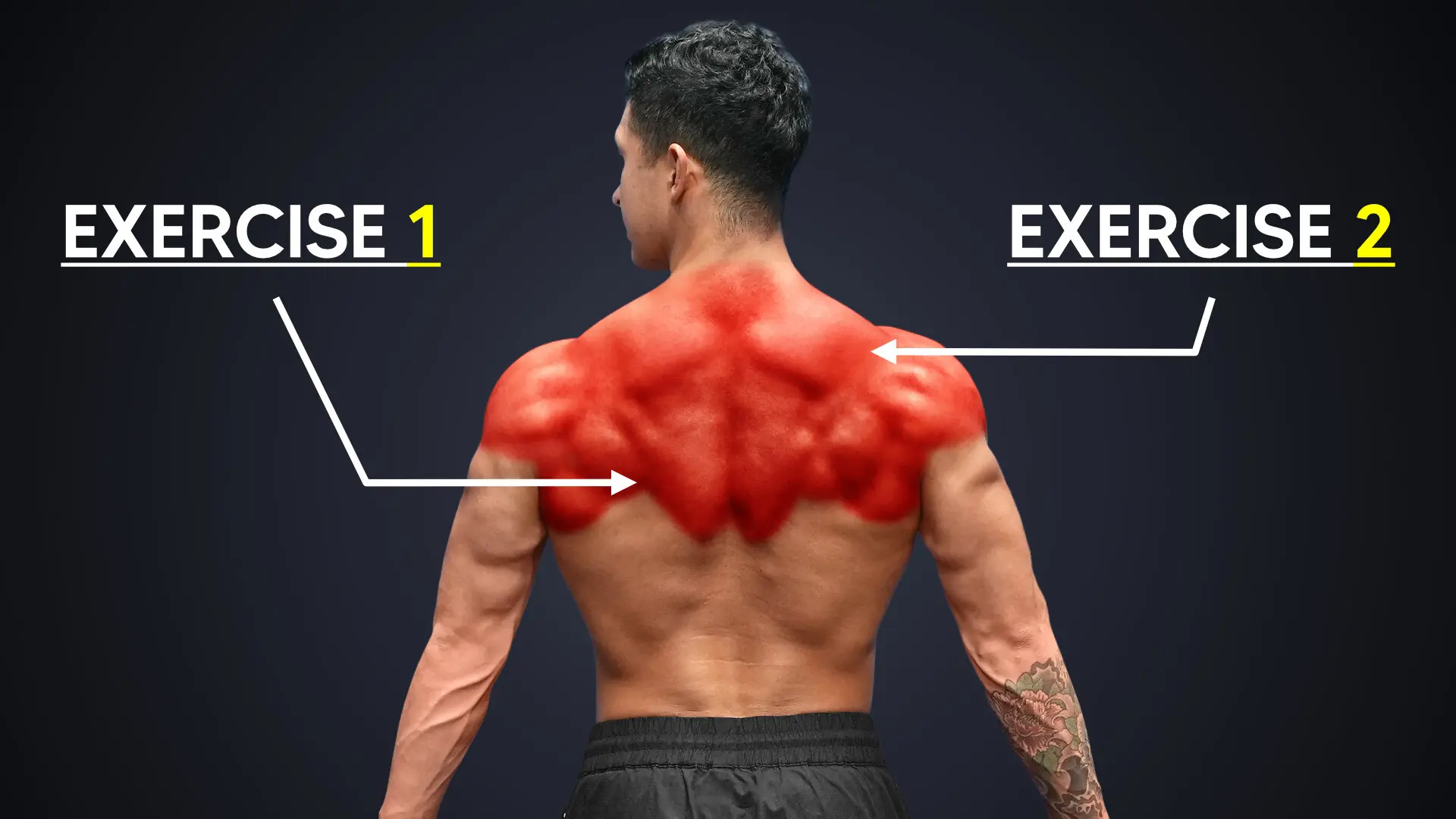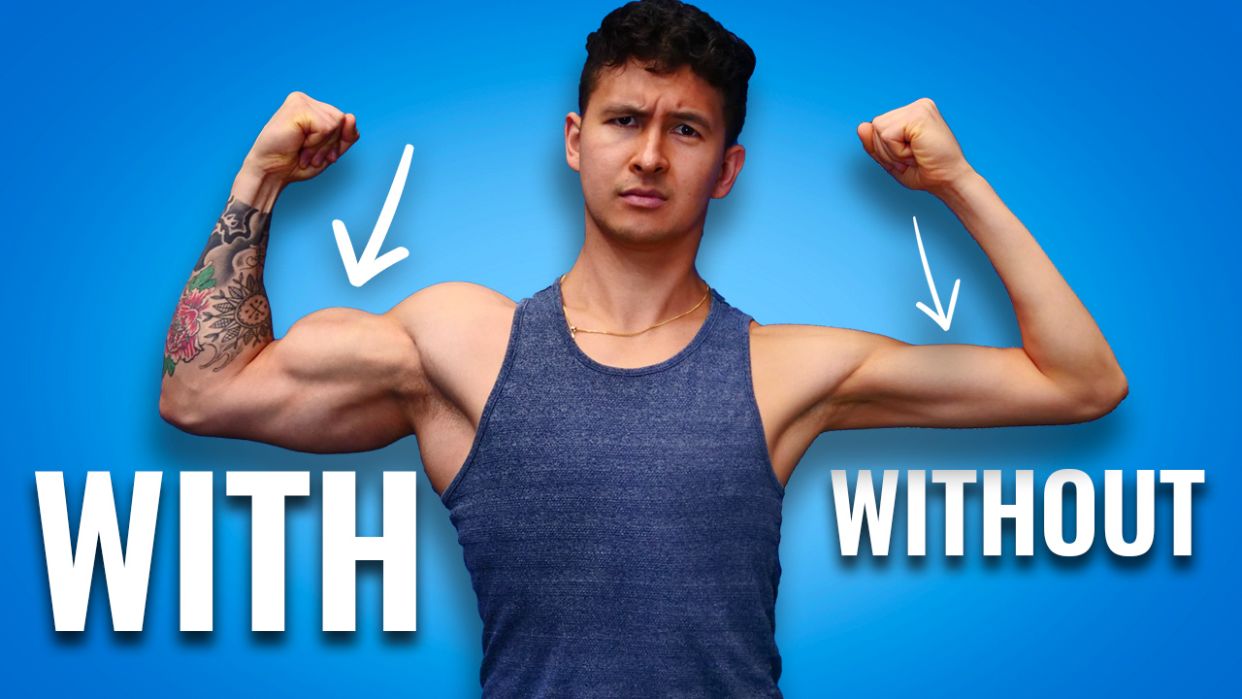
The No.1 Reason You're Not Building Muscle As A Natural, Exposed
Not building muscle? Then you're probably focusing on the wrong things in your workout program. Find out what you should care about instead here.
Building muscle is easy…. If you’re a brand new beginner. Past the “newbie gains” stage, though, building muscle becomes disproportionately harder, especially as a natural. This is why many people, no matter how hard they work in the gym or how well they eat, just can't seem to experience any more muscle growth.
You can’t brute force your way past this. Beyond the basic fixes like “eat enough food” or “get enough sleep”, it often all comes down to 1 reason.

Today, I’ll reveal what that reason is and how to modify your training to instantly make it far more effective at building muscle.
Before that: if you're looking for a training program that'll help you set up every single one of your workouts for optimal muscle growth, I've got just the thing for you. Every BWS program is designed to be an all-in-one, science-based process that’ll get you building muscle FAST. For more information:
Click the button below to take my analysis quiz to discover the best program for you:
↓
The Science Behind Building Muscle
First, we have to understand how a muscle actually grows in order to take advantage of it (i.e., what stimulates muscle growth?)
Historically, there were 3 mechanisms that everyone conceived as driving muscle growth (i.e., essential for building muscle). And I mean everyone, from old school bodybuilders to trainers to scientists. I remember reading about these mechanisms on an online forum, and instantly I tried tweaking my training program to try to maximize all 3 of these mechanisms.
The rest of the industry did the same, promoting training programs and protocols that took advantage of these 3 mechanisms. However, as more research was conducted over time, it became evident the science and reasoning behind some of these mechanisms were quite flawed.
Unfortunately, most people, including many trainers, weren’t made aware of this. As a result, many people still train ineffectively, preventing them from building muscle long-term. In fact, there’s a strong chance that one or more of your training habits are based on an outdated understanding of muscle growth.
So what are these 3 mechanisms? And which of them are no longer reliable for those interested in building muscle?
Building Muscle: The 3 (Supposed) Mechanisms Of Muscle Growth
Mechanism 1: Muscle Damage
The first mechanism, muscle damage, is actually something that most people intuitively strive for after their workouts.
It’s very straightforward, representing actual damage, known as microtrauma, that training can cause to muscle cells. This damage causes a reactive inflammatory response in the body which can create muscle soreness, and in theory, causes the muscle to grow bigger in response.
Because of this, many people go out of their way to pursue soreness while training, thinking that more soreness means more gains.
Mechanism 2: Metabolic Stress
The second mechanism is called metabolic stress. This mechanism represents the chemical demands placed on your muscles during training.
If you train your muscles a certain way, it can cause a high amount of chemical by-products to build up in that muscle. As you work harder and create more and more build-up, your muscles become more acidic, creating a burning sensation in your muscles that I’m sure many of you are familiar with.
The hormonal environment and swelling of the muscle caused by this are theorized to cause muscle growth.
To maximize metabolic stress, you’d want to use training methods that don’t allow your muscles enough time to clear away the chemical build-up. Examples include:
- High reps
- Supersets
- Short rest periods
... Basically, anything that gives you a big “Arnold pump” or strong burning sensation in your muscles — these are all "metabolic stress" at play.
Mechanism 3: Mechanical Tension
The third and final mechanism is mechanical tension.
This represents the tension that’s placed on your muscle as it lengthens and then contracts under load. You can think of it as a band repeatedly stretching and then shortening each rep.

Generally, the heavier the weights you lift and the greater the range of motion you use to lift them, the more mechanical tension is created.
Debunking The 3 Mechanisms Of Muscle Growth
Now, all 3 mechanisms sound great on paper, but recent research has revealed that we’ve been:
- Undermining the importance of 1
- Way overestimated 1
- Totally wrong about the other
... when it comes to actually building muscle. To find out which is which, you'll have to continue reading.
Mechanism 1: Muscle Damage
Let’s start with muscle damage.
When researchers of a 2017 review took a closer look at existing muscle damage research, they were met with findings that came as quite a surprise.
They found that the ‘growth’ past researchers thought muscle damage caused was actually just due to temporary swelling that would occur afterward, temporarily making muscles appear bigger than they actually were.
When this was accounted for, participants who experienced greater muscle damage and soreness from their workouts didn’t experience greater growth. It wasn’t until the muscle damage eventually died down did participants experience true muscle growth.
Other studies support this as well, suggesting that although muscle damage and soreness will be a byproduct of hard training, trying to get more of it does not help with building muscle, and can in fact hinder it.
Mechanism 2: Metabolic Stress
As for metabolic stress, we can determine its effectiveness in building muscle by analyzing training protocols that create high amounts of metabolic stress and seeing how well they stimulate muscle growth.
Shorter rest periods seem to create a high amount of metabolic stress. Yet it’s consistently been shown to cause less muscle growth than longer rest periods where less metabolic stress occurs.
Training all the way to failure also creates a very high amount of metabolic stress. But, when compared to stopping just a couple of reps shy of failure, it at best results in an equal amount of muscle growth.
And lastly, faster lifting tempos involve far more metabolic stress than slower lifting tempos, yet tends to provide either equal or less muscle growth.
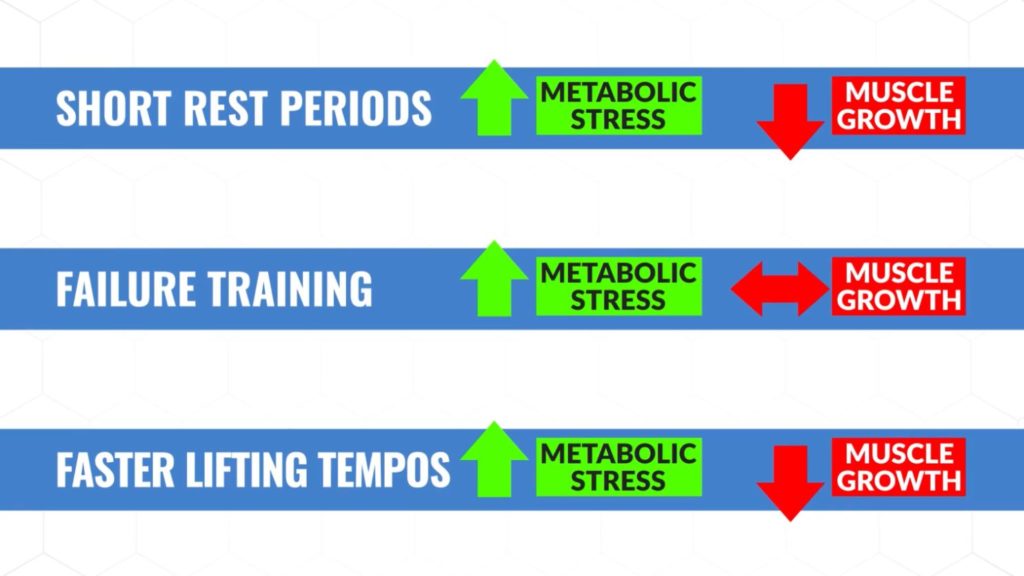
Overall, this suggests that even metabolic stress doesn’t seem to be strongly correlated with hypertrophy. Or, in other words, if building as much muscle as you can is your aim, metabolic stress shouldn't be a priority.
Shocked? Surprised? Well, this just goes to show how important a well-planned, science-based workout program is for anyone interested in building muscle in the shortest amount of time possible (you wouldn't want to spend months or years working toward metabolic stress, only to realize it does nothing — do you?) So, for a science-based approach to building muscle:
Click the button below to take my analysis quiz to discover the best program for you:
↓
Mechanism 3: Mechanical Tension
Finally, mechanical tension. This mechanism has withstood the test of time and recent research has only served to reiterate that it is the most important driver for muscle growth.
Now although metabolic stress will always be present to some degree in your training, and muscle damage will still occur whenever you train a muscle hard enough, it’s clear that for the best results (in terms of building muscle), you want to structure your workouts such that they maximize mechanical tension.
How can we do this? Simple. There are 4 modifications you’ll want to make to your workouts.
Psst: A Quick Question For You
By the way, guys, before we dive into the modifications, I’m curious — what’s one thing that you’ve been told was really important for building muscle but didn’t turn out to be true? Leave a comment! For me personally, I always thought the key was shocking my muscle with new exercises every single workout. This actually leads me right into the first workout modification I want you to make.
How To Maximize Mechanical Tension If You're Serious About Building Muscle
#1: Prioritize Making Progress, Not Soreness
First, most people design their workouts so that they "feel" more sore. But don’t prioritize ‘feeling’ like you made progress, prioritize actually making progress.
You can do this by sticking with the same exercises week to week and slowly adding more weight and reps to them as you get stronger. Although after a few weeks of this you won’t feel much soreness anymore, that’s actually a good thing.
It means you’re recovering well and your body is no longer spending a bunch of time and resources repairing old and damaged tissue and is instead focused on building new muscle.
#2: Rest With Purpose
Second, rest with purpose. Many people don’t spend enough time resting between sets, which decreases the amount of weight and reps they can lift in their next set and hence decreases mechanical tension.
Illustrating this is a 2016 study by Schoenfeld and colleagues that compared the resting 3 minutes or 1 minute between sets. After 8 weeks, strength and size for every muscle group measured increased more with the longer rest, reaching significance for 3 of the 4 muscles measured.
Although optimal rest time highly depends on how taxing the exercise is as well as your training status, a good recommendation is to spend at least 1.5-2 minutes of rest between sets for most of your exercises, with 3 minutes of rest being a good idea for heavy compound movements.
Just be aware that this may turn your workouts from sweaty, heart-pumping sessions that “feel” satisfying into a totally different kind of workout that may not feel like it did much but in reality is far superior for building muscle. Trust the process.
#3: Develop — And Maintain — Mind-Muscle Connection
Third, increasing mechanical tension is not just about going from point A to point B or how much weight you can lift. It’s about HOW you lift that weight from point A to point B.
Any time you:
- Cut a rep short OR
- Don't control the way down of a movement (i.e., "skipping" the eccentric) OR
- "Bounce" out of the bottom position using momentum
... You're effectively reducing the amount of mechanical tension placed on the muscle.
Even if you've heard it a million times, you need to pay attention to proper form rather than let your ego get the best of you when building muscle. In addition to that, there is one more “trick” that you can use to further increase mechanical tension.
In the process of building muscle, most people mindlessly train a movement trying to hit a goal number of reps without paying much attention to how the target muscle is contracting.
For example, during the dumbbell chest press, rather than mindlessly moving the weight up and down, think about:
- Pulling your arms together AND
- Driving your biceps into your chest on each rep to really feel the chest working
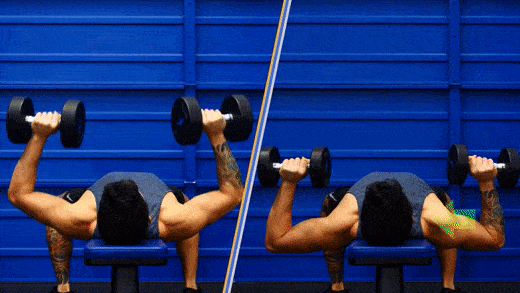
Doing so has been shown to stimulate more growth, especially for the upper body muscles. Try to develop this mind to muscle connection with every muscle you train.
Takeaway
Even if you feel stuck at building muscle right now, apply those 4 modifications to your workouts and you’ll very quickly notice the gains picking back up again. That’s the true power of science.
And if you’re looking for customized help to apply this science-based approach to your training to make faster gains and build a body you’re proud of:
Click the button below to take my analysis quiz to discover the best program for you:
↓
Now I do also have some past workout routines you can check out here that are designed to maximize mechanical tension and are great options to start out with:
- The Best Full Body Workout For Growth
- 15 Best Shoulder Exercises For Boulder Shoulders
- 14 Best Exercises To Build The Perfect Back
Or if you want some more advanced strategies on how to continue forcing muscle growth in your training, you can give this article, "5 Progressive Overload Techniques To Force Muscle Growth", a read.


